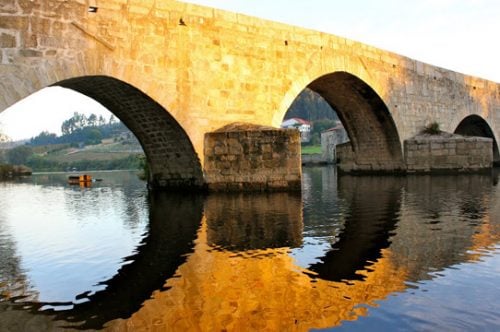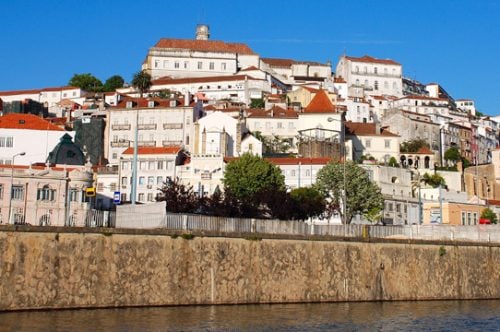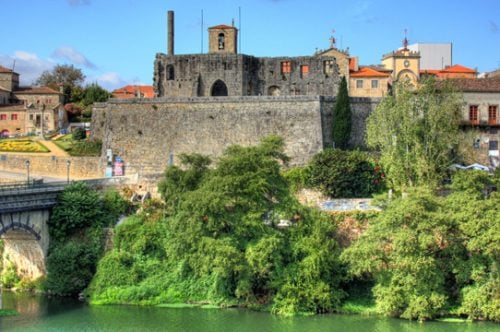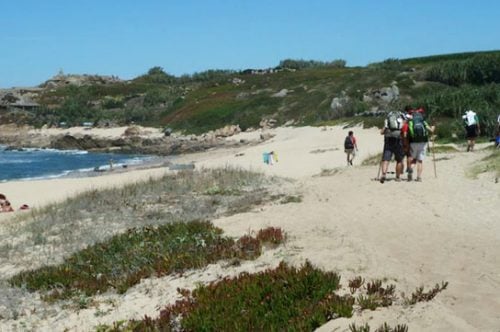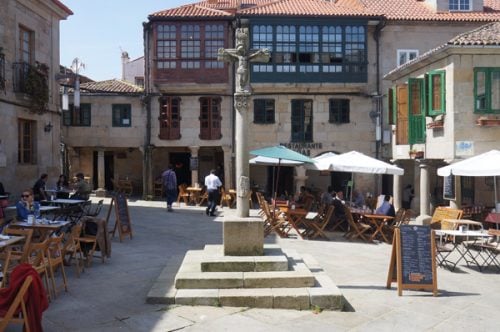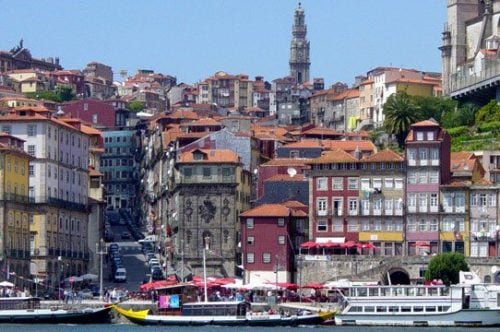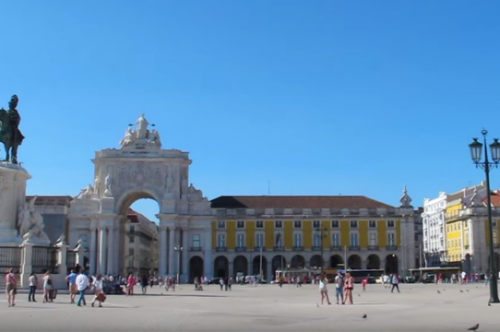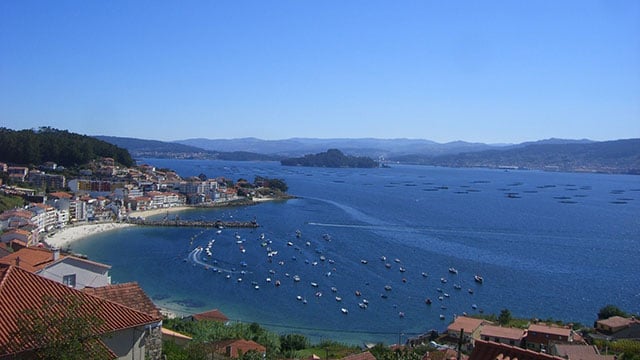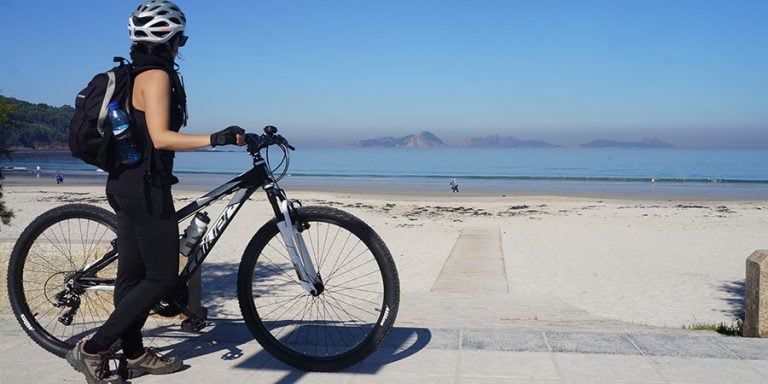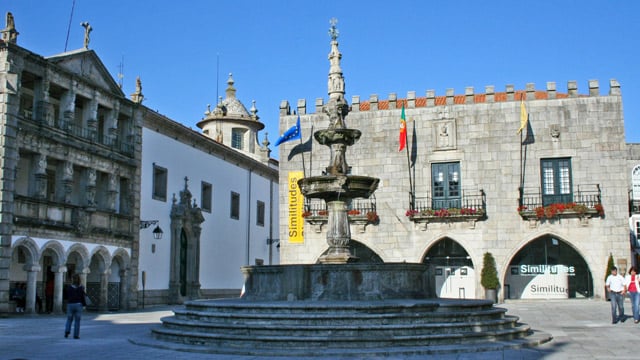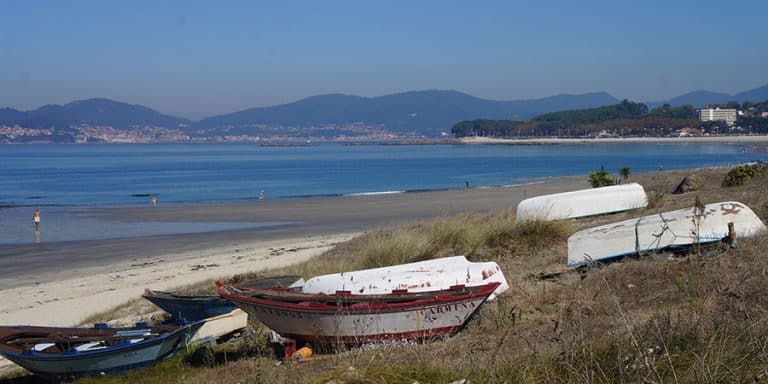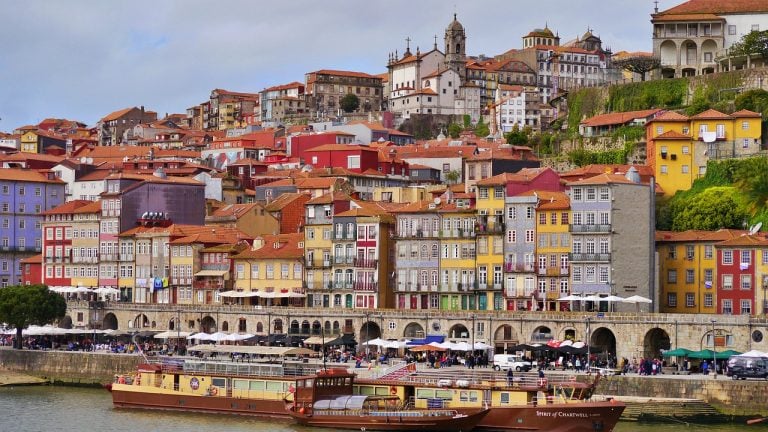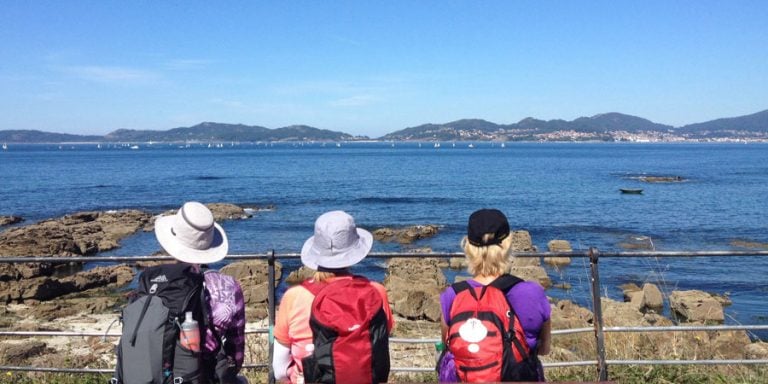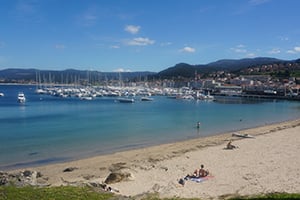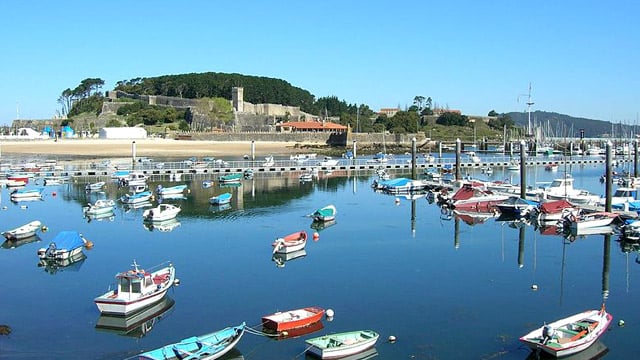The Camino Portugués
The Camino Portugués, or Portuguese Way, is the second most popular Camino de Santiago route, offering pilgrims a peaceful and scenic alternative to the bustling Camino Francés.
Stretching over 600 km from Lisbon to Santiago de Compostela, this route blends historic cities, seaside towns, and lush Galician landscapes. Pilgrims can choose from multiple starting points: Lisbon, Coimbra, Porto, or Vigo, making the route flexible for both long journeys and shorter sections.
👉 Plan your Camino with our Camino Planner.
👉 Compare with other Camino routes.
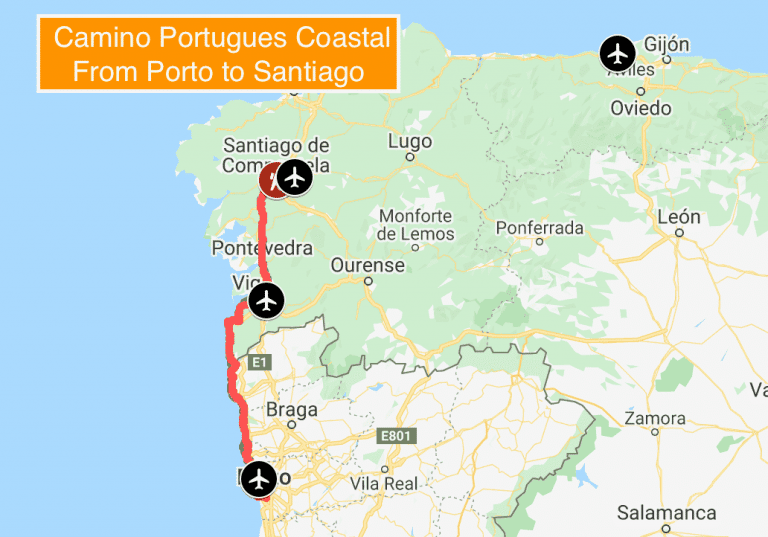
Why Walk the Portuguese Way?
The Camino Portugués is beloved for its balance of tranquillity, culture, and coastal beauty. It is less crowded than the Camino Francés, yet still rich in pilgrim tradition and warm hospitality.
Walking this route means tasting fresh seafood in seaside towns, exploring UNESCO cities like Lisbon and Porto, and crossing into Galicia where Albariño vineyards and Celtic heritage await. The Portuguese Camino is also considered one of the most welcoming Caminos, with locals often greeting pilgrims with a heartfelt “Bom Caminho!”
Suggested Routes
Highlights of the Camino Portugués
- Three UNESCO World Heritage cities: Lisbon, Porto, Santiago de Compostela.
- Viana do Castelo and Baiona – charming coastal towns.
- Cíes Islands near Vigo – a natural paradise just offshore.
- Historic gems: Santarém, Tomar, Coimbra.
- Delicious seafood and Albariño wine.
- A mix of inland forests, Roman bridges, and Atlantic coastline.
What makes it special?
The Camino Portugués offers a unique mix of culture and coast. You’ll follow trails once walked by medieval pilgrims, cross ancient Roman roads, and pass shrines dedicated to Saint James. Yet, this Camino is equally about slow evenings by the ocean, enjoying sunsets, fresh shellfish, and the rhythm of traditional Portuguese villages.
Route Options and Stages
You can start the Camino Portugués in Lisbon, Porto, or Vigo — or choose one of the coastal alternatives. Popular options include:
- Full Camino Portugués (Lisbon–Santiago) – ~643 km, about 29 days.
- Coimbra–Santiago – historic inland section with Roman roads.
- Porto–Santiago Coastal Route – ~259 km, 13 days; seaside towns and fishing villages.
- Vigo–Santiago (Last 100 km) – ~100 km, 6 days; qualifies for the Compostela.
- Cycling the Portuguese Way – 200 km+ (e.g. Porto–Santiago) needed for Compostela.
👉 Explore itineraries: Camino Portugués tours.
The Pilgrim Compostela Certificate
To receive the Compostela pilgrim certificate in Santiago:
- Walk at least 100 km (most start in Vigo or Tui).
- Cycle at least 200 km (e.g. Porto–Santiago).
👉 Learn more: Compostela facts.
Terrain and Difficulty
- Lisbon–Porto: rural farmland, hot summers, quiet winter paths.
- Porto–Baiona: mostly flat, coastal walking.
- Baiona–Santiago: gentle hills, daily ascents up to 400 m.
- Paths: 50% trails, 50% quiet country lanes, well-marked.
👉 Prepare with our Camino Fitness Plan.
When to Walk the Portuguese Camino
- Spring & Autumn – best conditions, mild weather, lively atmosphere.
- Summer – warm but manageable (cooler on the coast).
- Winter – wetter months, especially in Galicia, but still walkable.
👉 See our guide: Best time to walk the Camino.
Camino Ways Route Planner
For over 1000 years, pilgrims from all over the world have walked the Camino Ways across Europe in their quest for spirituality. Making the pilgrimage to Santiago de Compostela in Spain, they encountered a variety of people, cultures and beliefs, leading to friendship and new experiences. This continues today with the Camino de Santiago being the most well known and well-loved walk in the world. More than just a walk, the Camino de Santiago is an unforgettable and unique journey for the body, mind and soul.
When To Go On The Camino Portugues
The Camino Portugués crosses almost the entire length of Portugal and enters Spain in Galicia. Although this Camino can be walked year-round without significant issues, we can divide it into two parts:
- The Camino from Lisbon to Porto can be hot in summer (30s degrees celcius) and relatively dry in winter.
- The Camino from Porto is mild in summer (average 25 degrees celsius) but wet in winter.
Both are ideal for walking or cycling in spring and autumn.
The Terrain On The Camino Portugues
The first week, from Porto to Baiona, is mostly flat along the coast. The second week, from Baiona to Santiago, has some hills with daily ascents and descents of up to 400 metres.
The trail is well-marked, with decent paths, so heavy hiking boots aren’t necessary. The Camino Portuguese coastal route is 50% footpaths and 50% quiet laneways, with no busy traffic to worry about.
What To Bring On The Camino Portugués?
Our Camino packing guide ebook is free to download. This will help you decide what to bring on your Camino.
What to Bring
Download our free Camino Packing List for essentials.
Key items: lightweight shoes, layered clothing, rain protection, and pilgrim passport (credencial).
Services That Make It Easy
When booking with CaminoWays, your journey is smooth and supported:
- Handpicked hotels for rest and comfort.
- Luggage transfers so you can walk light.
- 24/7 assistance and maps provided.
👉 See Guided Tours.
👉 Or browse Self-Guided Tours.
History of the Camino Portugués
Pilgrimage from Portugal dates back to the Middle Ages, gaining popularity after Portuguese independence in the 12th century. Supported by kings, nobility, and clergy, the Portuguese route became a spiritual and cultural lifeline.
The Camino Portugués follows ancient Roman roads such as the Via XIX, later documented in medieval pilgrim texts. During the 12th century, hospitals and monasteries offered hospitality to travellers, a tradition echoed today by locals greeting pilgrims with warmth.
Despite modern roads affecting parts of the trail, regional associations continue to restore historic paths, keeping the Camino’s legacy alive.
👉 Discover more: History of the Camino.
👉 Read more on our Camino Portugues articles.
FAQs
Q: What is the Camino Portugués?
A: The Camino Portugués, or Portuguese Way, is the second most popular Camino de Santiago route, starting in Lisbon or Porto and leading north to Santiago de Compostela.
Q: How long is the Camino Portugués?
A: The full route from Lisbon is about 643 km, while the Camino Portugués Coastal from Porto is around 259 km. Many pilgrims walk just the last 100 km from Vigo in 1 week to earn their Compostela.
Q: What are the highlights of the Camino Portugués?
A: UNESCO cities like Lisbon, Porto, and Santiago; seaside towns such as Baiona and Viana do Castelo; Galician vineyards and Albariño wine; and the spectacular Cíes Islands near Vigo.
Q: When is the best time to walk the Camino Portugués?
A: Spring and autumn are the most popular times. The Lisbon–Porto section can be hot in summer, while the Porto–Santiago coastal path is mild year-round. See our guide to the best time to walk the Camino.
Q: Do I need to carry my own luggage on the Camino Portugués?
A: No, you can book Camino luggage transfers, which move your bags daily between hotels so you can walk light with a small backpack.
Q: Can I cycle the Camino Portugués?
A: Yes, cycling is very popular on this route. To earn your Compostela, cyclists must complete at least 200 km, for example from Porto to Santiago. See our cycling the Camino routes.
The Sections Of The Camino Portugués
This Camino takes pilgrims along old roads, across forests, fields, over medieval bridges, quaint villages, towns, and historic cities, bearing north to Santiago de Compostela.
Along the way, you will pass countless reminders of the Camino history such as shrines, churches, convents, and stone crosses, and ‘Petos de animas‘, where the comforting image of Saint James is often present to guide pilgrims.
Camino Portugués From Lisbon
Lisbon is the starting point of the Camino Portugués, over 600 km from Santiago de Compostela. Portugal’s chic and buzzing capital on the shores of the Atlantic is home to several impressive UNESCO sites, and its fascinating history makes it a must-visit.
Heading North towards Santarem, the first stage of the Camino route quickly leaves the city landscape behind for the quiet farmland of the area known as ‘the Garden of Portugal’. Pilgrims travel along the Tejo River valley along a trail that is also the Caminho de Fatima. The town of Santarem, sitting on a hillside over the Tejo Valley, was one of the last Moorish bastions in Portugal.
From Santarem, the Caminho Portugués continues along the Tejo River, heading inland towards Coimbra, once the capital of Portugal and home to one of Europe’s oldest universities, dating back to the 13th century.
This stretch of the Camino passes by beautiful little villages, farmland, forests, and olive groves in the heart of Portugal.
Camino Portugués From Coimbra
From Coimbra, the Camino heads back towards the Atlantic coast with Porto as a destination. This section of the trail will take you across vineyards, valleys, woodlands, and a stretch of Roman road to finish in the centre of stunning Porto, where you will marvel at its UNESCO World Heritage city centre, stroll along the Riviera (riverfront) and taste some of the local delicacies, with a drop of the city’s famous port wine.
To start in Coimbra, select the Camino Portugues full route and customise your starting point.
Camino Portugués From Porto
This starts the coastal section with gorgeous seaside towns dotted along the route.
Camino Portugués From Vigo
This is the start of the last 100km of the Camino Portugués. From here, you have another three days along the coast. Superb views and the Spanish experience all the way to Santiago de Compostela.
Final Word
The Camino Portugués is a route of Atlantic breezes, medieval towns, and heartfelt welcomes. Whether you start in Lisbon, Porto, or Vigo, this Camino combines the best of history, culture, and coast — with a spirit that is both peaceful and profoundly rewarding.
👉 If you’d like a personalised Camino Portugués itinerary, try our Award Winning Camino Planner.
